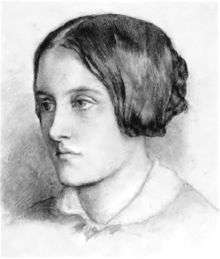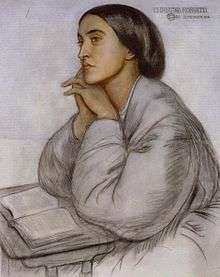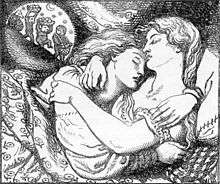Christina Rossetti
| Christina Rossetti | |
|---|---|
 | |
| Born |
Christina Georgina Rossetti 5 December 1830 London, England |
| Died |
29 December 1894 (aged 64) London, England |
| Occupation | Poet |
| Language | English |
| Nationality | British |
| Literary movement | Pre-Raphaelite |
| Relatives | Gaetano Polidori (maternal grandfather), Gabriele Rossetti (father), Frances Polidori (mother), John William Polidori (maternal uncle), Dante Gabriel Rossetti (brother), Maria Francesca Rossetti (sister), William Michael Rossetti (brother) |
Christina Georgina Rossetti (5 December 1830 – 29 December 1894) was an English poet who wrote a variety of romantic, devotional, and children's poems. She is famous for writing Goblin Market and Remember, and the words of the Christmas carol In the Bleak Midwinter.
Early life and education
Christina Rossetti was born in Charlotte Street (now 105 Hallam Street), London, to Gabriele Rossetti, a poet and a political exile from Vasto, Abruzzo, and Frances Polidori, the sister of Lord Byron's friend and physician, John William Polidori.[1] She had two brothers and a sister: Dante became an influential artist and poet, and William and Maria both became writers.[1] Christina, the youngest, was a lively child. She dictated her first story to her mother before she had learned to write.[2]
Rossetti was educated at home by her mother and father, who had her study religious works, classics, fairy tales and novels. Rossetti delighted in the works of Keats, Scott, Ann Radcliffe and Matthew Lewis.[3] The influence of the work of Dante Alighieri, Petrarch and other Italian writers filled the home and would have a deep impact on Rossetti's later writing. Their home was open to visiting Italian scholars, artists and revolutionaries.[4] The family homes in Bloomsbury at 38 and later 50 Charlotte Street were within easy reach of Madam Tussauds, London Zoo and the newly opened Regent's Park, which she visited regularly; in contrast to her parents, Rossetti was very much a London child, and, it seems, a happy one.[3][4]

In the 1840s, her family faced severe financial difficulties due to the deterioration of her father's physical and mental health. In 1843, he was diagnosed with persistent bronchitis, possibly tuberculosis, and faced losing his sight. He gave up his teaching post at King's College and though he lived another 11 years, he suffered from depression and was never physically well again. Rossetti's mother began teaching to keep the family out of poverty and Maria became a live-in governess, a prospect that Christina Rossetti dreaded. At this time her brother William was working for the Excise Office and Gabriel was at art school, leaving Christina's life at home to become one of increasing isolation.[5] When she was 14, Rossetti suffered a nervous breakdown and left school. Bouts of depression and related illness followed. During this period she, her mother, and her sister became deeply interested in the Anglo-Catholic movement that developed in the Church of England. Religious devotion came to play a major role in Rossetti's life.
In her late teens, Rossetti became engaged to the painter James Collinson, the first of three suitors. He was, like her brothers Dante and William, one of the founding members of the avant-garde artistic group, the Pre-Raphaelite Brotherhood (founded 1848).[6] The engagement was broken in 1850 when he reverted to Catholicism. Later she became involved with the linguist Charles Cayley, but declined to marry him, also for religious reasons.[6] The third offer came from the painter John Brett, whom she also refused.[4]
Rossetti sat for several of Dante Rossetti's most famous paintings. In 1848, she was the model for the Virgin Mary in his first completed oil painting, The Girlhood of Mary Virgin, which was the first work to be inscribed with the initials 'PRB', later revealed to signify the Pre-Raphaelite Brotherhood.[7] The following year she modelled again for his depiction of the Annunciation, Ecce Ancilla Domini. A line from her poem "Who shall deliver me?" inspired the famous painting by Fernand Khnopff called "I lock my door upon myself". In 1849 she became seriously ill again, suffering from depression and sometime around 1857 had a major religious crisis.[4]
Career

Rossetti began writing down and dating her poems from 1842, mostly imitating her favoured poets. From 1847 she began experimenting with verse forms such as sonnets, hymns and ballads; drawing narratives from the Bible, folk tales and the lives of the saints. Her early pieces often feature meditations on death and loss, in the Romantic tradition.[3] She published her first two poems ("Death's Chill Between" and "Heart's Chill Between"), which appeared in the Athenaeum, in 1848 when she was 18.[8][9] Under the pen-name "Ellen Alleyne", she contributed to the literary magazine, The Germ, published by the Pre-Raphaelites from January – April 1850 and edited by her brother William.[1] This marked the beginning of her public career.[10]
Her most famous collection, Goblin Market and Other Poems, appeared in 1862, when she was 31. It received widespread critical praise, establishing her as the foremost female poet of the time. Hopkins, Swinburne and Tennyson lauded her work.[1][10] and with the death of Elizabeth Barrett Browning in 1861 Rossetti was hailed as her natural successor.[10] The title poem is one of Rossetti's best known works. Although it is ostensibly about two sisters' misadventures with goblins, critics have interpreted the piece in a variety of ways: seeing it as an allegory about temptation and salvation; a commentary on Victorian gender roles and female agency; and a work about erotic desire and social redemption. Rossetti was a volunteer worker from 1859 to 1870 at the St. Mary Magdalene "house of charity" in Highgate, a refuge for former prostitutes and it is suggested Goblin Market may have been inspired by the "fallen women" she came to know.[11] There are parallels with Coleridge's The Rime of the Ancient Mariner given both poems' religious themes of temptation, sin and redemption by vicarious suffering.[12] Swinburne in 1883 dedicated his collection A Century of Roundels to Rossetti as she had adopted his roundel form in a number of poems, as exampled by her Wife to Husband.[13] She was ambivalent about women's suffrage, but many scholars have identified feminist themes in her poetry.[14] She was opposed to slavery (in the American South), cruelty to animals (in the prevalent practice of animal experimentation), and the exploitation of girls in under-age prostitution.[15]
Song
When I am dead, my dearest,
Sing no sad songs for me;
Plant thou no roses at my head,
Nor shady cypress tree:
Be the green grass above me
With showers and dewdrops wet:
And if thou wilt, remember,
And if thou wilt, forget.
I shall not see the shadows,
I shall not feel the rain;
I shall not hear the nightingale
Sing on as if in pain:
And dreaming through the twilight
That doth not rise nor set,
Haply I may remember,
And haply may forget.
1862[16]
Rossetti maintained a very large circle of friends and correspondents and continued to write and publish for the rest of her life, primarily focusing on devotional writing and children's poetry. In 1892, Rossetti wrote The Face of the Deep, a book of devotional prose, and oversaw the production of a new and enlarged edition of Sing-Song, published in 1893.[17]
In the later decades of her life, Rossetti suffered from Graves' Disease, diagnosed in 1872 suffering a nearly fatal attack in the early 1870s.[1][4] In 1893, she developed breast cancer and though the tumour was removed, she suffered a recurrence in September 1894. She died in Bloomsbury on 29 December 1894 and was buried in Highgate Cemetery.[17] The place where she died, in Torrington Square, is marked with a stone tablet.[18]
Recognition
| Christina Rossetti | |
|---|---|
| Feast | 27 April[19][20] |
Although Rossetti's popularity during her lifetime did not approach that of Elizabeth Barrett Browning, her standing remained strong after her death. In the early 20th century Rossetti's popularity faded in the wake of Modernism. Scholars began to explore Freudian themes in her work, such as religious and sexual repression, reaching for personal, biographical interpretations of her poetry.[4] In the 1970s academics began to critique her work again, looking beyond the lyrical Romantic sweetness to her mastery of prosody and versification. Feminists held her as symbol of constrained female genius, placed as a leader of 19th-century poets.[1][4] Her work strongly influenced the work of such writers as Ford Madox Ford, Virginia Woolf, Gerard Manley Hopkins, Elizabeth Jennings, and Philip Larkin. Critic Basil de Selincourt stated that she was "all but our greatest woman poet … incomparably our greatest craftswoman … probably in the first twelve of the masters of English verse".[4][21]
Rossetti's Christmas poem "In the Bleak Midwinter" became widely known after her death when set as a Christmas carol first by Gustav Holst, and then by Harold Darke.[22] Her poem "Love Came Down at Christmas" (1885) has also been widely arranged as a carol.[23] Rossetti is honoured with a feast day on the liturgical calendar of the Anglican Church on 27 April.[19][20][24]
In 1918, John Ireland set eight of her poems from Sing-Song: A Nursery Rhyme Book to music in his song cycle Mother and Child.
The title of J.K. Rowling's novel The Cuckoo's Calling is based on a line in Rossetti's poem A Dirge.
Ancestry
| Ancestors of Christina Rossetti | |||||||||||||||||||||||||||||||||||||||||||||||||||||||||||||||||||||||||||||||||||||||||||||||||||||||||||||||||||||||||||||||||||||||||||||||||||||||||||||||||||||||||||||||||||||||||||||||||||||||||||||||||||||||||||||||||||||||||||||||||||||||
|---|---|---|---|---|---|---|---|---|---|---|---|---|---|---|---|---|---|---|---|---|---|---|---|---|---|---|---|---|---|---|---|---|---|---|---|---|---|---|---|---|---|---|---|---|---|---|---|---|---|---|---|---|---|---|---|---|---|---|---|---|---|---|---|---|---|---|---|---|---|---|---|---|---|---|---|---|---|---|---|---|---|---|---|---|---|---|---|---|---|---|---|---|---|---|---|---|---|---|---|---|---|---|---|---|---|---|---|---|---|---|---|---|---|---|---|---|---|---|---|---|---|---|---|---|---|---|---|---|---|---|---|---|---|---|---|---|---|---|---|---|---|---|---|---|---|---|---|---|---|---|---|---|---|---|---|---|---|---|---|---|---|---|---|---|---|---|---|---|---|---|---|---|---|---|---|---|---|---|---|---|---|---|---|---|---|---|---|---|---|---|---|---|---|---|---|---|---|---|---|---|---|---|---|---|---|---|---|---|---|---|---|---|---|---|---|---|---|---|---|---|---|---|---|---|---|---|---|---|---|---|---|---|---|---|---|---|---|---|---|---|---|---|---|---|---|---|---|
| |||||||||||||||||||||||||||||||||||||||||||||||||||||||||||||||||||||||||||||||||||||||||||||||||||||||||||||||||||||||||||||||||||||||||||||||||||||||||||||||||||||||||||||||||||||||||||||||||||||||||||||||||||||||||||||||||||||||||||||||||||||||
Publications
Poetry collections
- Verses. London: private, 1847.[25]
- Goblin Market and Other Poems. London: Macmillan, 1862.[25]
- 1876 Author's revised edition
- The Prince's Progress and Other Poems. London: Macmillan, 1866.[25]
- Goblin Market, The Prince's Progress, and other poems. London: Macmillan, 1879.
- Sing-Song: A Nursery Rhyme Book (1872, 1893)[26]
- A Pageant and Other Poems (1881)
- Verses. London: Society for Promoting Christian Knowledge, 1893.,[25])
- New Poems London: Macmillan, 1896.[25]
- The Rossetti Birthday Book. London: private, 1896.[25]
- The Poetical Works of Christina Georgina Rossetti. Edited by William Michael Rossetti. London: Macmillan, 1904.
- The Complete Poems of Christina Rossetti. Edited by Rebecca W Crump. A complete and comprehensive collection, with publication annotation, in three volumes. Baton Rouge: Louisiana State University Press, 1979–85.
remember 1862
Fiction
- Commonplace and Other Stories. London: Ellis, 1870.[25]
- Speaking Likenesses. London: Macmillan, 1874.[25]
Non-fiction
- Called to Be Saints. London: Society for Promoting Christian Knowledge, 1881.
- "Dante, an English Classic." Churchman's Shilling Magazine and Family Treasury 2 (1867): 200–205.
- "Dante. The Poet Illustrated out of the Poem." The Century (February 1884): 566–73.
- The Face of the Deep. London: Society for Promoting Christian Knowledge, 1893.
- Seek and Find: A Double Series of Short Studies of the Benedicite. London: Society for Promoting Christian Knowledge, 1879.
- Time Flies: A Reading Diary. London: Society for Promoting Christian Knowledge, 1885.
See also
- Rossetti–Polidori family tree
References
- 1 2 3 4 5 6 Profile at Poets.org
- ↑ "Author Profile: Christina Rossetti," Literary Worlds, BYU.edu, Web, 19 May 2011.
- 1 2 3 Packer, Lona Mosk (1963) Christina Rossetti University of California Press pp13-17
- 1 2 3 4 5 6 7 8 Lindsay Duguid, "Rossetti, Christina Georgina" (1830–1894)', Oxford Dictionary of National Biography, Oxford University Press, 2004; online edition, Jan 2009
- ↑ Packer, Lona Mosk (1963) Christina Rossetti University of California Press pp20
- 1 2 Packer, Lona Mosk (1963) Christina Rossetti University of California Press p29
- ↑ Tate Gallery
- ↑ "Christina Rossetti (1830–1894)," eNotes.com, Web, 19 May 2011.
- ↑ Jan Marsh, Christina Rossetti and the Pre–Raphaelite Brotherhood
- 1 2 3 The Cambridge Companion to English Poets (2011) Claude Rawson. Cambridge University Press pp424-29
- ↑ Packer, Lona Mosk (1963) Christina Rossetti University of California Press p155
- ↑ Hassett, Constance W. (2005) Christina Rossetti: the patience of style University of Virginia Press p15
- ↑ Rossetti, Christina, The Complete Poems, Peguin Books, London, 2001 ISBN 9780140423662
- ↑ Pieter Liebregts and Wim Tigges (Eds.) (1996) Beauty and the Beast: Christina Rossetti. Rodopi Press. p43
- ↑ Fairchild, Hoxie Neale (1939) Religious trends in English poetry, Volume 4 Columbia university press.
- ↑ The Norton Anthology of Poetry (revised shorter edition), ISBN 0-393-09251-8.
- 1 2 Antony H. Harrison (2004) The Letters of Christina Rossetti Volume 4, 1887–1894 University of Virginia Press ISBN 0-8139-2295-X
- ↑ "Christina Rossetti: London Remembers". londonremembers.com. Retrieved 22 November 2013.
- 1 2 Exciting Holiness: Collects and Readings for the Festivals and Lesser Festivals of the Calendars of the Church of England, the Church of Ireland, the Scottish Episcopal Church and the Church in Wales. (2003) Brother Tristam, Hymns Ancient and Modern Ltd, p172 ISBN 9781853114793
- 1 2 ChurchofEngland.org, Holy Days calendar
- ↑ TLS, 4 December 1930.
- ↑ BBC article Bleak Midwinter named best carol Thursday, 27 November 2008
- ↑ Hymns and Carols of Christmas
- ↑ "The Baptismal Ecclesiology of Holy Women, Holy Men: Developments in the Theology of Sainthood in the Episcopal Church" (2012) Dan Joslyn-Siemiatkoski p33
- 1 2 3 4 5 6 7 8 "Christina Rossetti Bibliography – UK First Edition Books," Bookseller World, Web, 19 May 2011.
- ↑ Sing-Song online edition
Sources
- Kathleen Jones. Christina Rossetti: Learning Not To First.
- Clifford, David and Roussillon, Laurence. Outsiders Looking In: The Rossettis Then and Now. London: Anthem, 2004.
- Jones, Kathleen. Learning Not to be First: A Biography of Christina Rossetti. Oxford: Oxford University Press, 1991.
- Marsh, Jan. Introduction. Poems and Prose. By Christina Rossetti. London: Everyman, 1994. xvii – xxxiii.
- Marsh, Jan. Christina Rossetti: A Writer's Life. New York: Viking, 1994.
- Maura Ives, Christina Rossetti A Descriptive Bibliography (2012?)
External links
- Christina Rossetti on the British Library's Discovering Literature website
- Poems and poetry at the Poetry Foundation
- Profile at Poets.org
- "Christina Rossetti", In our time, BBC Radio 4 (audio, 45 minutes)
- Rossetti Family Correspondence at the University of Kansas Libraries
- Online books, and library resources in your library and in other libraries about Christina Rossetti
- Online books, and library resources in your library and in other libraries by Christina Rossetti
- Works by Christina Rossetti at Project Gutenberg
- Works by or about Christina Rossetti at Internet Archive
- Works by Christina Rossetti at LibriVox (public domain audiobooks)

- Free scores by Christina Rossetti in the Choral Public Domain Library (ChoralWiki)